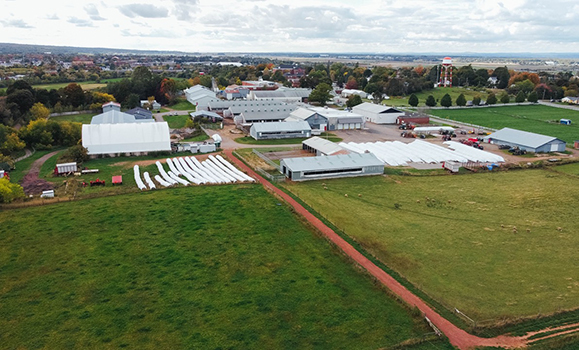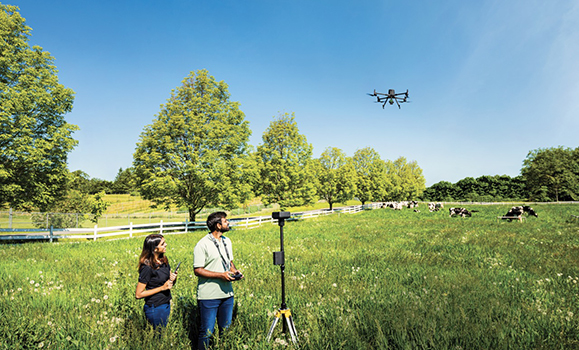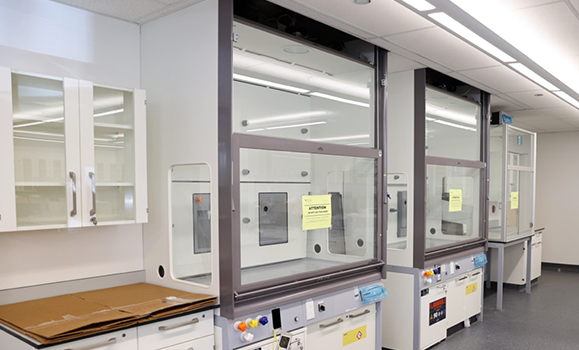THE YEAR wasn’t supposed to turn out like this.
It’s mid-summer of 2018, and it’s the wrong kind of hot. A fire has engulfed a portion of one of Dalhousie’s key academic buildings on the Agricultural Campus near Truro, N.S. At 10 p.m., Nancy McLean, an assistant professor there, receives a call.
“My sister phoned to say that there was smoke coming from my building,” says McLean, recalling how she first learned about the fire unfolding at the Cox Institute.
Given the late hour and the extended drive from her home on a farm in neighbouring Pictou County, she resolves to wait it out until morning before dropping by the scene.
On the way into work the next morning, McLean hears on local radio that Cox—where her research lab is located—looks fine and that no one was injured in the blaze. Her mood brightens a bit. But moments after arriving on campus her hope melts away like soft serve on a sweltering day. As she peers through a window into her basement office, she’s confronted by a stark scene.
“I could see fridges floating, freezers on their sides, everything destroyed from the water damage,” she remembers. “Samples, computers, tissue culture labs, growth rooms, all of the equipment. Everything—destroyed.”
Further reading: Cleanup continues after devastating Cox Institute fire
As the scale of the disaster sinks in, McLean’s mind churns through the coming ripple effects: the decades-long research studies, detailed field notes, computers filled with data, all now threatened by the water raining down to douse the fire. And what would become of the wild bee specimens she and her research team had painstakingly gathered during field trips? One heavy thought led to another.
Soon, other people arrive on scene, many facing similar grim realizations.

LEFT: The rebuilt Cox Institute in 2022; RIGHT: A photo of a lecture hall destroyed in the 2018 fire sits atop an easel in the newly built space (Nick Pearce photos).
About a 45-minute drive away in Halifax, news of the fire generates an all-hands-on-deck response. Administrators assemble, frequent information updates are scheduled, and calls from media are fielded. Soon, a group of senior leaders from Halifax hits the highway headed for Truro. Despite the distance from the disaster, the wounds cut deep—akin to how it might feel if misfortune were to befall a close family member.
And the Faculty of Agriculture was most certainly close family by this time. Six years earlier, Dalhousie had merged with the Nova Scotia Agricultural College (NSAC). Like all unions, marital or otherwise, there was an adjustment period. But by the summer of 2018, the Faculty of Agriculture—the entity created through unification—was well on its way to achieving some of the goals laid out in the initial strategy behind the merger.
That is, until the flames in the Cox upset the balance and left virtually everyone on the campus asking the same question: where do we go from here?
NEWS THAT Dal and NSAC were in talks to join forces surprised some when it was first made public in late May 2011.
Paul Manning, a third-year student and president of the college’s student union at the time, remembers being called to a meeting one Friday morning for a “big announcement.” He was among about 200 people assembled.
“It was an emotional morning for many people for a lot of different reasons,” says Manning, now an assistant professor in the Department of Plant, Food and Environmental Science. “There was a feeling of excitement for some people, but others were really sad.”
Further reading: NSAC and Dal in talks to merge
As a student leader, Manning stood up for those who had reservations—even if he himself felt hopeful about the potential benefits of the merger. Some students, particularly those with deep family ties to the college, worried about what change might bring to the college’s close-knit culture, its small class sizes, the working farm, and more.
And students weren’t the only group wondering what the deal might bring. Staff, faculty, and even industry pondered what a merger might mean for them. Would there be layoffs? Were valuable research partnerships at risk? Questions swirled.
That morning on campus, then-Dal President Tom Traves reassured members of the NSAC community that the intent of the merger was not to downsize or save money but to “take our strengths and build something better together.” Government ministers on hand echoed the sentiments, saying their priorities for the college were to maintain a strong presence in the Truro-Bible Hill area, protect jobs, increase enrolment, and enhance the student experience.

Aerial view of the Faculty of Agriculture’s working farm (Cody Turner photo).
NSAC, by then more than a century old and operating as a division of the provincial Department of Agriculture, had been seeking out a new governance structure for years. A merger with Dal made sense on several levels as the two institutions already worked closely together in many respects; Dal granted bachelor’s and master’s degrees to NSAC students, NSAC faculty had a presence on the Dalhousie Senate, and Dalhousie held representation on the NSAC Faculty Council. What’s more, the province’s two largest postsecondary institutions by research funding dollars also shared many research interests and the merger promised to bring even closer collaboration and new opportunities for faculty members.
With formal merger talks underway, Manning and others at NSAC prepared for a future as part of Dalhousie. He and fellow student leaders found themselves wrapped up in negotiations with their counterparts at the Dalhousie Student Union in Halifax. Teams of staff and faculty engaged in similar discussions. While it would take some time iron out all the details— in some cases, years—these early discussions helped set a tone of civility, cooperation, and fairness.
Just over a year after the merger plans were first announced, the Faculty of Agriculture officially launched on September 1, 2012. Moving forward as a united front proved valuable at a time when global issues such as climate change and food insecurity placed increasing demands on researchers to help find solutions.
Further reading: Introducing the Faculty of Agriculture
THERE'S A LOT to take in when stepping onto Dal’s Agricultural Campus in Bible Hill near Truro. You’ll find barns, a robotic feed system, and nearly 1,000 acres of research fields, gardens, and greenhouses. Depending on the time of day you might also cross paths with cows, sheep, or other farm animals out grazing.
These facilities, tools, and natural resources power the industry-leading education and research happening there today, and that has in some cases been happening since 1905, when the campus was first established. But these days, the pastoral landscapes are also increasingly dotted with more modern facilities and technologies: drones or other smart-farming technologies scanning the fields to enhance pest control, 8,100 square feet of digitally powered aquatic research facilities to seek better ways to feed a growing global population, an award- winning biomass plant that heats and powers the campus with alternative energy, and much more.
Further reading: Among the energy elite: Dal’s biomass plant generates international accolades for energy‐efficiency gains
 Pastoral landscapes are increasingly dotted with more modern facilities and smart-farming technologies (Dean Casavechia photo).
Pastoral landscapes are increasingly dotted with more modern facilities and smart-farming technologies (Dean Casavechia photo).
Student spaces on campus look and feel different these days, too. A new student learning commons opened on the upper level of the MacRae Library in 2019, and an Indigenous Community Room located nearby serves as a welcoming public space for Indigenous students and community members as well as a regional hub of the National Centre for Truth and Reconciliation.
Further reading: Dalhousie launches partnership with the National Centre for Truth & Reconciliation
None of these changes happened overnight and some were already in the works pre-merger. But two-time Ag grad Robyn McCallum, current president of the Miramichi Salmon Association, an adjunct faculty member at Dal, and a director of the Faculty of Agriculture’s alumni board, says the shift in governance from the province to Dal has clearly had a positive impact.
“Dal’s influence, leadership and international partnerships have really benefitted the Ag campus over the past 10 years,” she says. “We no longer had to get in line behind hospitals and elementary, middle, and high schools for funding. Instead, we go through Dal, run capital campaigns, and create strong budgeting priorities. We can see the benefits from that now.”
Through it all, McCallum says the campus has continued to hang onto its one-of-a-kind Aggie spirit.
“People can see that we still are a unique campus and have kept our own identity, but we’re now part of the Dal brand, which can perhaps take us a little bit further than we could have as just the NSAC.”
WHEN DR. YUNFEI JIANG returned to the Faculty of Agriculture as an assistant professor of agronomy in January 2022, it was a homecoming in many respects. Originally from Langqi Island in China, an agriculturally rich slice of Fujian province, Jiang first encountered the bucolic charms of Bible Hill in 2010 when she began a master’s degree at NSAC. It’s where her passion for crop physiology and agronomy truly took root. It’s also where she first met her future husband, Dustin MacLean, a fellow NSAC student who grew up in the area.
Jiang, along with Manning and McCallum, had been among the first cohort of NSAC students to graduate from Dal’s newly minted Faculty of Agriculture in 2013. When she left to undertake a PhD in plant science at the University of Saskatchewan, Jiang felt grateful for the support she had received as an international student at NSAC and, later, Dal. The Agricultural Campus’s relatively small size meant students like her could always find help when they needed it.
“NSAC and Dal really helped me to build a strong back- ground and become the researcher I
am today.” —Dr. Yunfei Jiang
Following her PhD, Dr. Jiang took on a postdoctoral fellowship at the University of Guelph and then a position with the National Research Council Canada in Saskatoon. All great career moves, but as Dr. Jiang puts it: “We always wanted to come back. We were just looking for an opportunity.” Finally, the right one emerged, and she and her husband plotted their return. After nearly a full decade away, Dr. Jiang was pleased to find many of the supports she benefitted from as a student had remained and, in fact, grown more extensive. She was also pleased to discover that supports for researchers were more robust and collaboration across faculties and disciplines at Dal had begun to fully blossom. “It brought the Agricultural Campus to a bigger stage,” she says of the merger.
Manning, the former student leader and Dal’s 87th Rhodes Scholar, also felt the pull back into the Dal family orbit. As with Dr. Jiang, there were both personal and professional reasons: his long-time partner (now wife) was living in Truro, so when a teaching job popped up at Dal in 2016, he took the plunge. Before long, the now-doctor Manning found out there were additional upsides post-merger for young researchers like himself when he received a prestigious Killam Postdoctoral Fellowship in his field of agroecology. A Dalhousie award he would not have had access to through NSAC.
“From a research side, the merger has been really useful in creating opportunities,” says Dr. Manning, whose appointment as an assistant professor followed in 2021. “That’s not something I would have thought of as an undergrad student, but as a faculty member you can see that quite clearly.”
Further reading: Agriculture student is ready for Rhodes
Over the past several years, the Faculty of Agriculture has seen its ranks of young researchers such as Dr. Manning and Dr. Jiang swell. And food security, an issue led by researchers on the Truro Campus, new serves as one of Dal’s five signature research clusters—a symbol of a closer alignment in priorities between Dal and the Faculty than ever before.
IN THE months just prior to the Cox Fire in 2018, the Faculty of Agriculture unveiled several key academic initiatives that had been in the works for years, including its PhD program in Agricultural Sciences. One of the first degrees of its kind in Atlantic Canada, it promised to create many opportunities for Ag students and researchers alike. The following month, it also announced the Indigenous Student Access Pathway initiative—a one-year program designed specifically for First Nations, Métis, and Inuit students not otherwise eligible for admission to Dal. The program provided both the tools for navigating post-secondary, as well as a culturally supportive environment to help students succeed. Other powerful programs were in the works, too.
Further reading: From human health to soil heath: First Phd student in Agricultural Sciences plots her future
To see such forward-thinking initiatives come to life on the Ag campus felt immensely satisfying for David Gray, campus principal and dean of the Faculty of Agriculture. It was further proof that a union between NSAC and Dal had been the right move. Which is why it was all the more difficult when the Cox was devastated shortly thereafter.
“Everything else just got completely pushed off to the side,” says Queena Crooker-Smith, an administrator in the dean’s office.
A 20-year veteran of Dal who’d worked primarily in Halifax, Crooker-Smith hadn’t even completed a year in her role on the Ag campus when disaster struck. Overnight, her job completely changed. Suddenly, she found herself handing tissues to researchers “whose entire careers were soggy and dripping with water.” She coordinated with Human Resources to have counsellors on hand for those in need. “We had supports for those people no matter what situation they found themselves in. It all took a huge emotional, human toll.”
Luckily, there were small moments of joy amidst the chaos. McLean, the researcher who’d arrived to find her whole lab under water, was able to work with a retrieval team to rescue the frozen wild bee samples she was worried were lost forever. Katherine Rutherford,a doctoral student whose work relied on the samples, was then able to continue her research exploring what plants to maintain to support those bees—nature’s most efficient pollinators—outside of the blueberry blooming season. “Katherine’s research material was saved through that rescue operation,” McLean says.
McLean and others are now back up and running in the newly rebuilt Cox and shifting gears to prepare for major new investments in data-driven research and smart farming.
Further reading: Out of the ashes: Cox Institute re‐emerges following devastating fire

The rebuilt Cox labs, ready to go (Nick Pearce photo).
Another priority, one first envisioned at the time of the merger, has also been reborn and launched this fall on the campus. Called Truro Start, it’s a program that enables students from faculties other than agriculture to begin their degrees in a small-town setting with smaller class sizes—for some students a better transition from home and high school to a university setting.
Further reading: New BSc Truro Start allows Science students to begin their Dal journey in a smaller campus setting
Through such initiatives—and through various infrastructure investments made possible after the merger—Dal’s Truro campus has become more diverse, innovative and academically rigorous. “Dalhousie really stepped up to the plate and then some to help us make all of that possible,” says Dr. Gray. “So much so that I believe we are in a very good place to take the next step as a faculty.”
This story appeared in the DAL Magazine Fall 2022 issue. Flip through the rest of the Fall 2022 issue using the links below.

